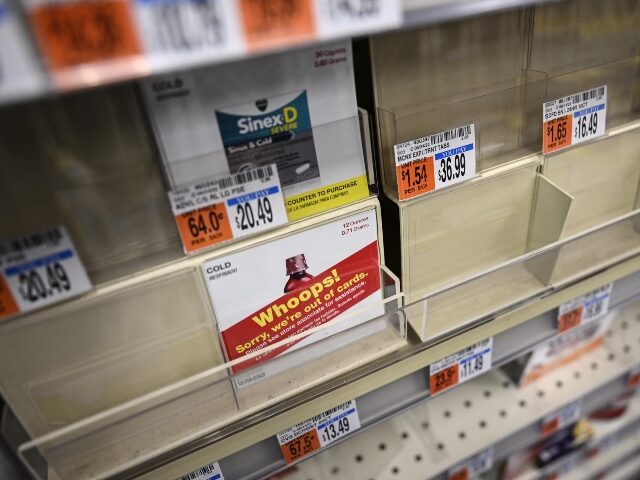Nolte: Latest Biden Shortage Is Vital Children’s Medicine

Parents now have a children’s medicine shortage to add to Joe Biden’s ongoing baby formula shortage.
“[A] shortage of children’s medications is leaving parents scrambling to care for their kids as three potentially deadly diseases permeate the United States,” reports Business Insider.
More:
The explosion of the three illnesses has left parents demanding more medications than stores and suppliers anticipated — leading to a shortage.
“Everybody is sick, and everybody needs medicine at once,” and companies can’t keep up with the high demand, Joanna Dolgoff, a pediatrician and spokeswoman for the American Academy of Pediatricians, told the Washington Post this month.
And with short supply, retailers from CVS to Walgreens to Target have limited the amount of children’s pain medication customers can purchase at once.
This is not the first report of these shortages. Last week, Breitbart News reported on Target rationing children’s medicine:
Target is restricting purchases of specific children’s medicines as the nation endures what has been dubbed the “tripledemic” — a rise in cases of flu, coronavirus, and respiratory syncytial virus (RSV).
Shoppers trying to find Tylenol, Advil, and Motrin are only allowed two per transaction on the store’s website or inside its brick and mortar locations, the Daily Mail reported Tuesday.
Last month we learned of an amoxicillin shortage:
Among the challenges is a scarcity in amoxicillin, which the Centers of Disease Control and Prevention considers a “first-line therapy” for bacterial ear infections and other common illnesses in children. The U.S. Food and Drug Administration added amoxicillin oral powder for suspension to its list of drug shortages in late October, stoking concerns among parents, pharmacists and physicians.
Amoxicillin treats infections in everything from the ears to the lungs to the urinary tract. One doctor explained the shortage this way:
These shortages have been associated with the uptick in influenza and respiratory syncytial virus (RSV) infections, as well as COVID-19 infections. This has resulted in the hoarding of liquid acetaminophen and ibuprofen, used to treat fever and pain, from several pharmacies, by consumers. The shortage of these products is common in the U.S. Antibiotic usage has increased 46% around the world since 2000, and amoxicillin is a medication that is in high demand globally. Only a few countries produce the active pharmaceutical ingredient for amoxicillin, and some of these manufacturers have also suffered regulatory sanctions and are unable to continue to manufacture and supply these products.
Is it unfair (or illegal in Joe Biden’s America) to wonder if the uptick in flu and respiratory infections might have something to do with the insane overreaction to the China Flu that might have undermined the immune systems in kids? The coronavirus was never a serious threat to healthy kids. Nevertheless, they were masked, put in various forms of quarantine, and protected from germs for up to two years. All of this can contribute to weakening a child’s (or anyone’s) immune system. Then you release these kids back into the world, and what happens? Not only can they get sick, and they have a slightly weakened immune system. So parents buy medicine, and then there is not enough medicine, and kids with weakened immune systems can’t get Tylenol.

Pre-K students listen while a book is read to them at Phyl’s Academy, Wednesday, March 24, 2021 in the Brooklyn borough of New York. (AP Photo/Mark Lennihan, Pool)
See how this works?
The question now is how this was allowed to happen and what is being done about it.
We saw what government could accomplish during the early days of the COVID pandemic. Former President Donald Trump got the private sector on board and ensured enough protective equipment, beds, therapies, and, eventually, a vaccine.
And yet…
We have heard nothing from the Biden administration about a children’s medicine shortage that has now been reported on for at least a month.

(Photo by Chip Somodevilla/Getty Images)
Where’s His Fraudulency, Joe Biden?
Where’s Secretary of Health Xavier Becerra?
Where’s Assistant Secretary of Health, Mr. Rachel Levine?
Nothing’s being done, and as far as I can tell, the media are mostly ignoring this story.
Sadly, this is not surprising. Between the left’s obsession with grooming, population control, and abortion, children are now seen by the political establishment as utilitarian and expendable.
Follow John Nolte on Twitter @NolteNC. Follow his Facebook Page here.
AMERICA IS HARDLY A 'SANCTUARY' FOR MIDDLE AMERICA!
This elite-created migration also helped to spike inflation — especially for housing. The result is that migration-spiked inflation outpaced wage growth, and median wages fell by 1.4 percent for 150 million Americans in President Joe Biden’s cheap-labor economy. NEIL MUNRO
CUT AND PASTE YOUTUBE LINKS
This Will Be A Global Recession, If We're Lucky... | Jim Rickards
Housing Crash Begins As US Housing Market Enters 2023 In A Massive Bubble
15 Things The Average American Family Can't Afford Anymore
Luxury Home Sales Crash 38 Percent in Record Decline amid Economic Woes

Luxury home sales took a significant plunge recently as the nation grapples with economic problems.
Forbes reported Monday:
Sales of luxury homes fell 38.1% year over year during the three months ending November 30, 2022, the biggest decline on record, according to a new report from Redfin, a technology-powered real estate brokerage. That outpaced the record 31.4% decline in sales of non-luxury homes. Redfin’s data goes back to 2012.
The luxury market and the overall housing market lost momentum in 2022 due to many of the same factors: inflation, relatively high interest rates, a sagging stock market and recession fears.
Meanwhile, America’s housing market is enduring its second-largest price correction since the end of World War II, according to Breitbart News.
Founding partner of Macro Trends Advisors Mitch Roschelle explained the correction is due to citizens’ uncertainty and worries over economic issues:
A couple of things are going to cause it to turn in the opposite direction, meaning home prices are going up. One is certainty. And when you don’t know if interest rates are going to go up or not. I think that is what is driving a lot of people away from buying because they just don’t know if rates are going to be cheaper in two months, and they’re just going to wait.
And the other thing is uneasiness regarding the economy. And I think the shoe to drop there would be if we start seeing layoffs, and we start seeing unemployment starting to rise, I think that could be something that causes a leg down in the housing market in a big way.
A recent poll found most Americans are still concerned about the economy under President Joe Biden’s (D) leadership, Breitbart News reported December 16.
“Out of 1,000 likely voters surveyed between December 12-13, 86 percent say they are concerned about the economy, including 60 percent who are ‘very concerned,’ reflecting an overall increase in concern since August,” the article said.
Per the Forbes report, there are indications that demand is making a comeback in the housing market as interest rates go down.
Austin Allison, Pacaso CEO and co-founder, recently spoke about the real estate industry during an interview on Fox Business, stating, “What we experienced over the course of the last couple of years was not normal, you know, homes selling in a couple of days for multiples over ask is not sustainable.”
“What we’re seeing now is a return to normalcy, so when you see the headlines that real estate is down 30 percent year over year, it’s important to remember that real estate transactions are actually still up quite a bit when compared to pre-pandemic levels,” he added.
No comments:
Post a Comment